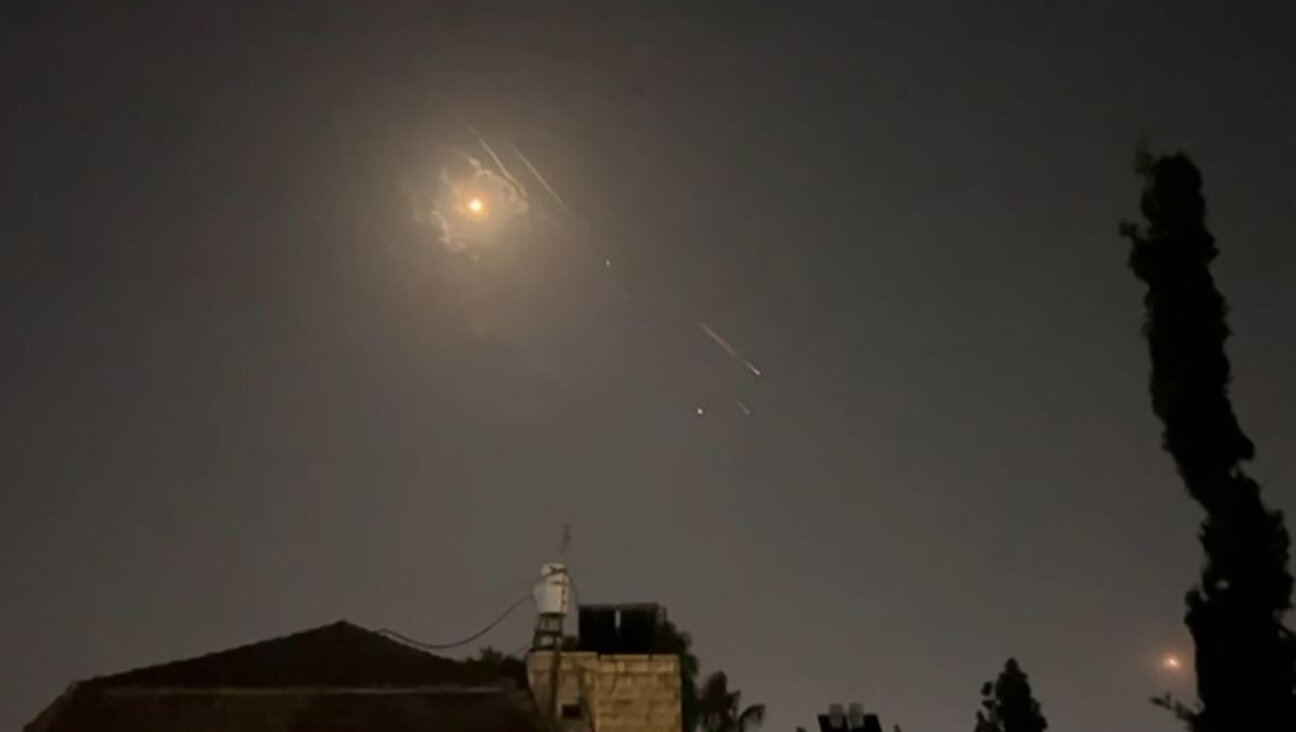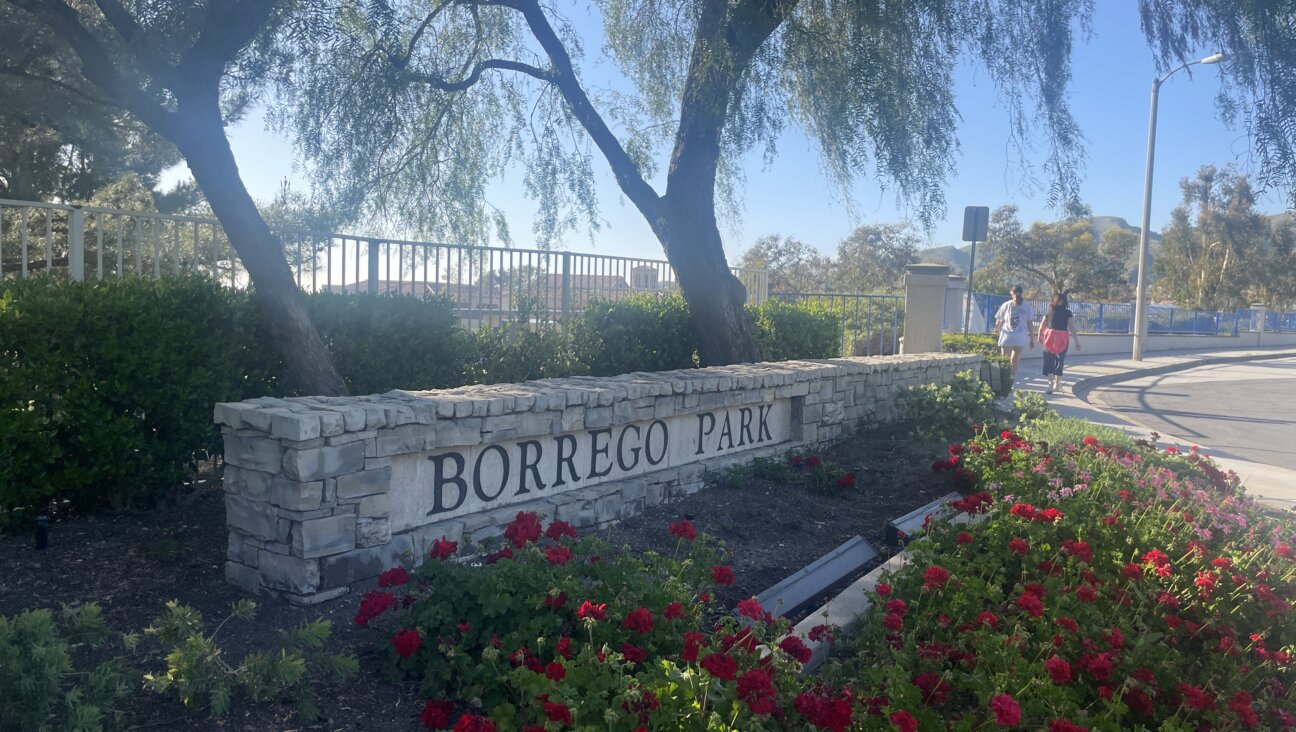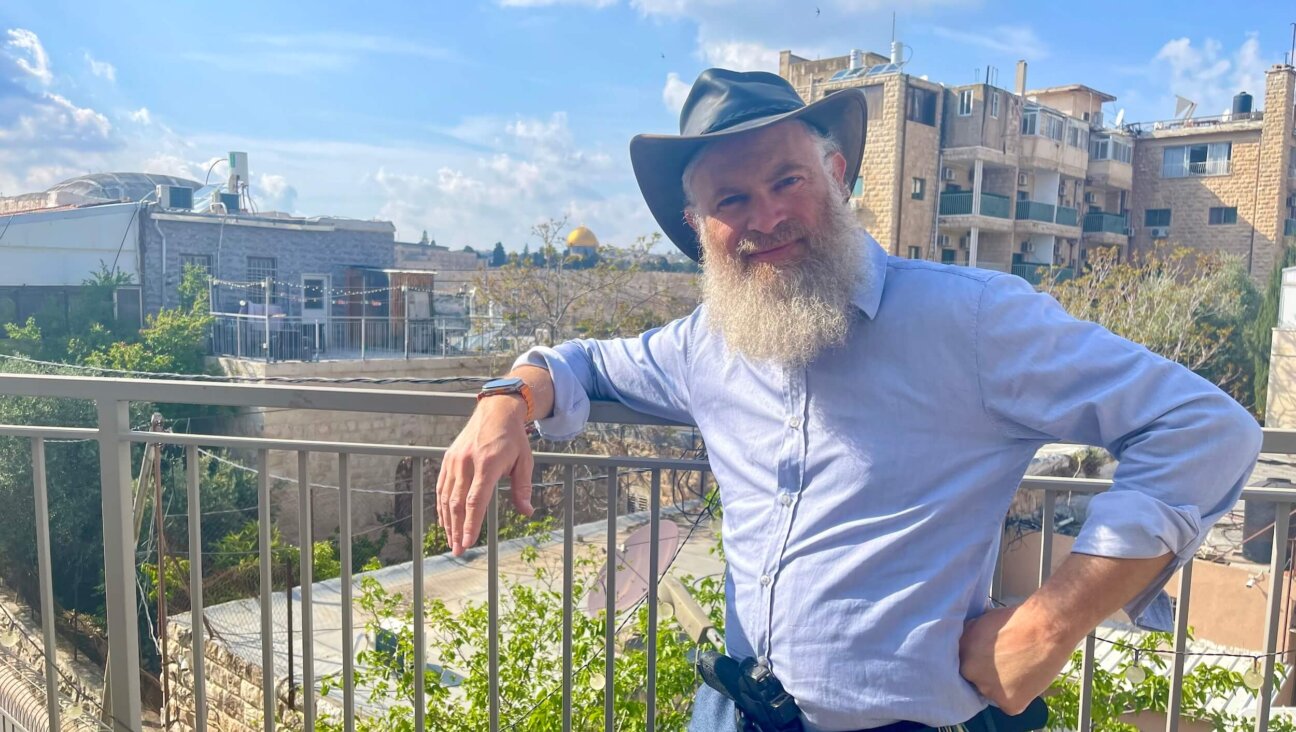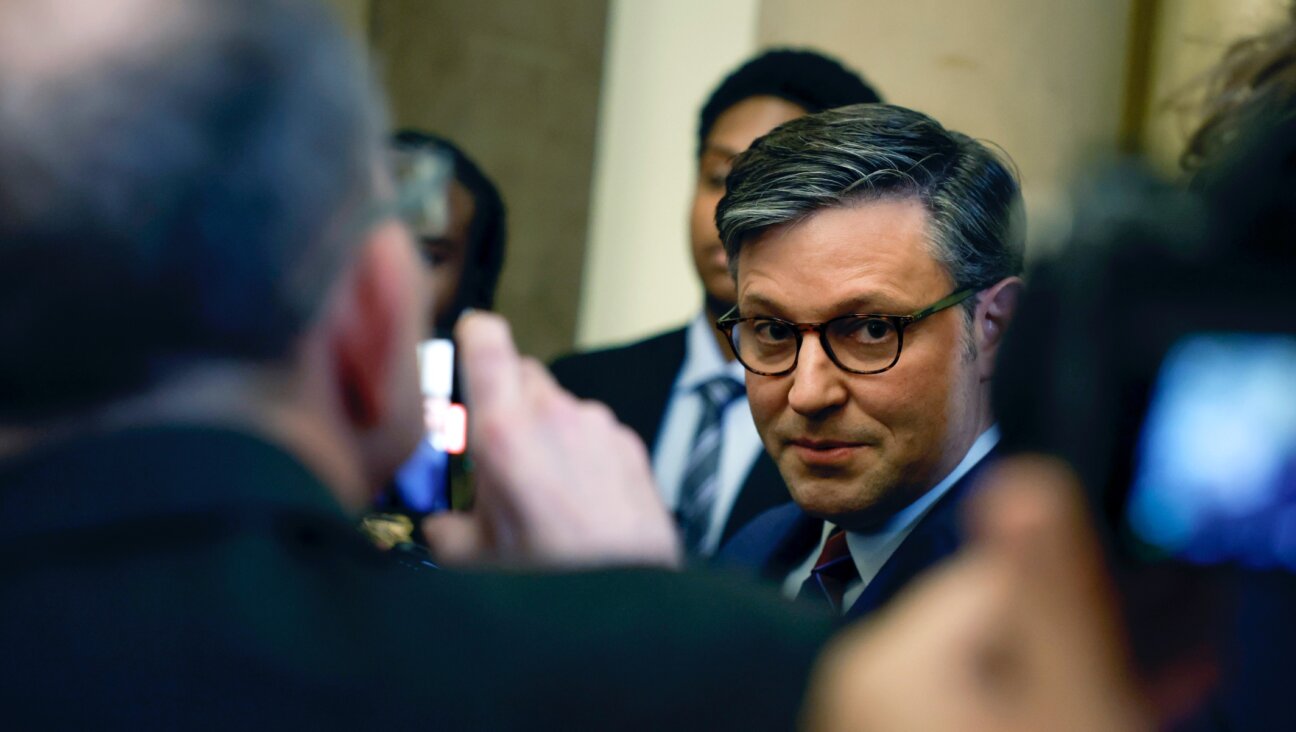Tramp Art and Jewish History
AMERICAN SAMPLERS, TRAMP ART AND A BIT OF JEWISH IMMIGRANT HISTORY AT AMERICAN ANTIQUE SHOW
In keeping with the Texas theme of the January 20 opening-night preview of the American Antique Show at the Metropolitan Pavilion, the party’s grand chairman was Lynda Johnson Robb, daughter of former president Lyndon B. Johnson. Also in the photographers’ sights was guest and collector Martha Stewart. Strolling through displays of Shaker cabinets, 18th- and 19th-century paintings and Indian art, I chanced upon the booth “M. Finkel & Daughter — America’s Leading Antique Sampler and Needlework Dealer” (a sampler is a form of needlework with either alphabets or the name of the person who made it embroidered). Were there any American-Jewish sampler makers? Greeting me with, “My mother reads the Forward,” Amy Finkel (the daughter in M. Finkel & Daughter) explained: In all my years of collecting, I have come across only two or three important Jewish samplers. These were always made by young girls, usually alphabets or aphorisms. In the 1820 to ’30s, there was one by a 7- or 8-year-old from Richmond, Virginia, and another from Baltimore by a Sarah Benjamin, daughter of a Dutch-Jewish merchant who came to America in the 1820s… I am always on the lookout for samplers in Hebrew, from Palestine. In the 1920s to ’30s, there were some in Hebrew that are now in private collections. My quilt collector-buyers include Barbra Streisand and Woody Allen.
The Clifford A. Wallach: Folk Art in the Tramp Art Style booth had me marveling at the unusually constructed, textured wood frames, boxes and cabinets that were unlike any I had ever seen. “What are these made of?” I asked. “Cigar boxes,” Wallach said. I asked, “Why is it called ‘tramp art’?” Wallach explained: “My grandfather came to America from Austria. He lived on [New York’s] Bowery. When he died I found a cigar box filled with novelties — cards, dice — and I always remembered the sweet smell of cedar. Twenty-five years ago, in a New York flea market, I came upon a small chest and [the cedar] smell came back. The man told me ‘it’s called tramp art.’ I was hooked.” Wallach explained how it was originally thought that hoboes and tramps and immigrant labor created the art, and so the name “tramp art” stuck. He continued: “I was in the fur business, Irving & Schechter off 30th Street. Fourth-generation furrier, upscale minks and sables. I loved the business, but when they began selling fur coats for $1,995 — less than what it cost us in labor — I left the business and devoted my full time to tramp art.” I asked him if he had he ever come across tramp art that had a Jewish motif. Wallach recalled: “One I remember was in New Jersey with a picture of the Ten Commandments…. I’ve sold to Ralph Lauren, Ted Turner, Candice Bergen… and decorators.
A few days later, by phone from Greenwich, Conn., Wallach augmented our original chat with a historical overview of tramp art: “It is an art of ethnic diversity, a democratic craft… the [artists’] tools were pocket knives. There were thousands upon thousands of cigar makers around the country…. In 1865, the first revenue laws were mandated to [help] pay for the Civil War…. The boxes were made out of cedar or mahogany and were worth more than the tobacco. Some 100 million boxes were made each year, and once the cigars were sold, the boxes could not be reused and were simply thrown away.” Wallach added: “We’ve found tramp art in Australia, East and Western Europe, in South America… wherever men smoked cigars, there was tramp art.”
Cigar making was a major skill brought to America by Jewish immigrants from Poland and Bohemia and was a traditional craft among Dutch Jews. Centered in New York City, the cigar makers unionized as early as June 22, 1864. “By 1907, stogie-making vied with peddling as the typical Jewish immigrant occupation in Pittsburgh,” as is noted in the American Jewish Historical Society’s American-Jewish History, Vol. III-1998, published by Routledge.
During my chat with. Robb, I mentioned that I had met her mother, Ladybird Johnson, in 1988 at a “Meet the Author” private reception at the American Booksellers Association convention in Anaheim, Calif., at which the former first lady touted her love of American native flowers. She also touted the upcoming book “Wildflowers Across America” (Abbeville Press, 1988), which she co-wrote with Carlton B. Lees. I told Robb that my daughter Karen and I later visited the LBJ ranch in Texas when the blue bells and blue bonnets were in full bloom. “They were my mother’s favorite,”. Robb said, wistfully.
Guests at this event that benefited the American Folk Art Museum included Jonathan Soros, Lucy Danziger, Mary McFadden, Robert and Marjorie Hirschhorn, David and Jane Walentas, and Bruce Winston.
NAZI AND JEW VERBALLY PARRY AND THRUST AS CLIMBERS FIGHT DEATH IN “NORTH FACE”
Warm gloves and a strong stomach are de rigueur for viewing Philipp Stölzl’s gripping film “North Face” (which originally premiered in 2008 at the Locarno Film Festival), an at times agonizing spectacle of the attempt of two German alpinists, Toni Kurz (Benno Furmann) and Andi Hinterstoisser. (Florian Lukas) to scale the then as yet unconquered North Face of the Swiss Alps (the Eiger, often called “the Murder Wall”). Based on a true story, the film takes place in 1936, and the Anschluss is on the horizon. What gives the film a special edge are the nuanced asides articulated by Emil Landauer (Erwin Steinhauer*), an assimilated Jew whose blond wife, Elizabeth (Petra Morzé**), tunes out the undercurrent of antisemitism swirling about them at the Swiss hotel where they are guests and spectators to the historic climbing event.
During dress-for-dinner intervals between edge-of-your-seat scenes of climbing and rappelling on the torturous rock face, Henry Arau (Ulrich Tukur), a newspaper editor and a loyal Nazi, baits Landauer as they sip wine and dine on Swiss fare. “The German soldier dreams of when, having fought to the summit, the world shall lie at his feet and above him shall stretch the limitless sky,” Arau tells the table guests. “That’s a mouthful,” Landauer responds. “I adore this kind of thing,” Elizabeth gushes. “Yeah!” Landauer, says “You adore Richard Wagner, too.” Then he adds: “You say the German alpinist dreams of a limitless sky? Very interesting! Would this be race specific? I wonder, for example, what the Austrian dreams of?” Arau proclaims: “A greater Germany. At least the Aryans among you. I wouldn’t know if that also applies to you.” Landauer responds: “I was speaking of the mountain climbers.” He raises a glass: “Here’s to adventure, ladies and gentlemen. As long as a big pile of limestone is all the German heroes are out to attack and conquer, I don’t mind,” he says, smiling. An agitated Arau counters: “Pride, Mr. Landauer. Pride is what this is all about! The pride of facing a challenger, whether it be in sports or politics. To this I raise my glass.”
Later in the film, a confectionary mountain in the shape of the Eiger is wheeled into the dining room. Sparklers ablaze, there are petit fours in the form of climbers, clutching swastika flags on the cake’s sides. As Elizabeth is served a slice, she asks for one of the flag-bearing climbers. About to bite into the swatika-bearing bonbon, her husband quips, “If it were at least an Austrian.” Near the film’s end, an agitated Swiss hotel manager tells the guests that he hopes the climbers found shelter as the weather has turned brutal. Arau, who planned to leave, sniffs a good story headline and changes his mind: “I am a reporter and will stick around.” Landauer asks him, “Are you not also human?” Arau replies dismissively, “From time to time.”
A GEMÜTLICH AND KOSHER GERMAN-AMERICAN JEWISH GATHERING IN NEW YORK
In what has become an annual event, the January 21 German-American Jewish Dialogue reception was hosted by Germany’s consul general, Horst Freitag, and his wife, Chantal, at their New York City residence. “It is a pleasure to see the Jewish community’s promotion of inter-cultural and political rights of others,” the consul general said to an assemblage that included both the Jewish Community Relations Council’s vice president and CEO, Michael Miller; David Marwell, director of the museum of Jewish Heritage — a Living Memorial to The Holocaust, and Betty Ehrenberg, executive director of World Jewish Congress — United States and North America. “The Jewish people are an integral part of life in Germany, a cause for gratitude… and our wish is for the future strengthening of Jewish life in Germany.” Freitag touted the recent Israeli-German Cabinet meeting in Berlin and described Germany’s developing relationship with Israel as “a remarkable achievement.” He noted that to date, as part of a “continuing exchange program for the third generation,” more than 400 Jewish students have traveled to Germany. After he finished speaking, everyone dug into a wonderful kosher buffet.

I hope you appreciated this article. Before you go, I’d like to ask you to please support the Forward’s award-winning journalism this Passover.
In this age of misinformation, our work is needed like never before. We report on the news that matters most to American Jews, driven by truth, not ideology.
At a time when newsrooms are closing or cutting back, the Forward has removed its paywall. That means for the first time in our 126-year history, Forward journalism is free to everyone, everywhere. With an ongoing war, rising antisemitism, and a flood of disinformation that may affect the upcoming election, we believe that free and open access to Jewish journalism is imperative.
Readers like you make it all possible. Right now, we’re in the middle of our Passover Pledge Drive and we need 500 people to step up and make a gift to sustain our trustworthy, independent journalism.
Make a gift of any size and become a Forward member today. You’ll support our mission to tell the American Jewish story fully and fairly.
— Rachel Fishman Feddersen, Publisher and CEO
Join our mission to tell the Jewish story fully and fairly.
Our Goal: 500 gifts during our Passover Pledge Drive!
























